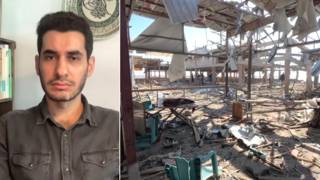
Topics
Guests
- Shane Bauerone of the three American hikers imprisoned in Iran after being apprehended on the Iraqi border in 2009. He spent 26 months in Tehran’s Evin Prison, four of them in solitary. He is now back to being a reporter and lives in Oakland, California, with his fellow hostage and now wife, Sarah Shourd. Together with the third former hostage, Josh Fattal, they are working on a book about their captivity that is due out in 2014. Bauer’s cover story for the new issue of Mother Jones magazine is called “Solitary in Iran Nearly Broke Me. Then I Went Inside America’s Prisons.”
In his first live television interview since his release from Iranian prison, journalist Shane Bauer shines the light on solitary confinement inside the California prison system. Bauer was one of three Americans detained in 2009 while hiking in Iraq’s Kurdish region near the Iranian border. He and Josh Fattal were held by Iran for 26 months, and Sarah Shourd — now Bauer’s wife — was held for 13 months, much of it in solitary confinement. In his latest piece for Mother Jones, Bauer exposes how California prisoners are being held for years in isolation based on allegations they are connected to prison gangs.
Watch Part One of Interview with Shane Bauer
AMY GOODMAN: This is Democracy Now!, democracynow.org, The War and Peace Report. I’m Amy Goodman. Our guest is Shane Bauer, live for his first interview since he was released from prison in Iran. Shane Bauer, along with Josh Fattal and Sarah Shourd, were the three American hikers who were on the Kurdistan, Iraq-Iran border when they were captured by Iranian soldiers, brought to the Evin Prison, where they were held for—well, in Josh and Shane’s case, for more than two years, four months of those two years in solitary confinement. Sarah was released after 13 months, but she was in solitary for the entire duration of that more-than-year imprisonment. Today, Shane Bauer is talking about solitary, from Iran to California. He has an explosive Mother Jones cover story called “No Way Out: Solitary in Iran Nearly Broke Me. I Never Thought I’d See Worse in American Prisons.”
This is part two of our conversation [click here for part one], as he talks about Pelican Bay, as he talks about solitary confinement. I asked him to talk about one of the people he profiles in his story, Ricky Gray.
SHANE BAUER: Ricky Gray has—is validated as an associate of the Black Guerrilla Family prison gang. He—
AMY GOODMAN: Explain what that is.
SHANE BAUER: It’s one of the seven prison gangs that are recognized by CDCR, one of the gangs that, you know, members or associates of which can be put in the SHU. All of these gangs are, you know, race-based. So he’s validated as an associate of this gang. There was 14 points of evidence used on his validation document, which is a very high number when prison officials only need actually three to validate somebody.
After he was validated, he—the warden actually appointed a staff assistant to review his case, which was quite unusual, in response to Gray’s complaints. A staff assistant did this review, and I managed to get a hold of the confidential report that the staff assistant wrote. In the report, this person goes into detail about each informant that was used against Gray. And remember, these informants—the information given by these informants is confidential, so Gray wasn’t even allowed to know what it was at the time. But the staff assistant found that some of the informants—that when she interviewed them, said they had never heard of Ricky Gray and had, in fact, never even been interviewed about him. She went through each of the informants and, you know, basically debunked each—each one of them, saying that, you know, they—they either had never heard of him or were unreliable, kind of there wasn’t, you know, sourcing, secondary sourcing to back it up. She recommended his release, said that the—his validation was based on faulty evidence.
After this report was filed, days after, the warden actually transferred to another prison, and the gang investigator that put him in the SHU decided not to release him. So he is still in, many years later. And then he actually took his case to court, and the judge ruled that—that he had no constitutional right to actually have—there’s no constitutional right for a prisoner, basically—I don’t remember the exact quote, but to not—for prison officials not to lie to put somebody in solitary confinement.
AMY GOODMAN: Review again for us how many people are in solitary confinement.
SHANE BAUER: Well, across the United States, according to governmental data, over 80,000 people are actually in solitary confinement right now. In California, there’s over 11,000 in some form of isolation, and there are four—almost 4,000 of them, about 3,800 of them are—have indeterminate sentences.
AMY GOODMAN: Talk about the final scene in your article. Talk about your journal.
SHANE BAUER: As I was finishing this article, I kind of went back to some of the letters from other prisoners, and I read a letter. The first letter I actually have ever received was from a man named Steve Castillo. And I was reading this letter and then decided to go to a very small segment of the prison journal that I wrote. I had one page that I managed to get out, which I had never read since I got out.
AMY GOODMAN: Why?
SHANE BAUER: I—you know, after getting out of prison, I didn’t—you know, it’s—it’s hard to go back into that situation, to get myself back into the—you know, that mindset. I—you know—I just—
AMY GOODMAN: And yet, you risk going back into that mindset every time you start an investigation into another prisoner in solitary.
SHANE BAUER: Yeah, it’s true. And, I mean, I—you know, I hadn’t read this journal for—not intentionally. I just kind of put it away. When I read—when I read his letter, I decided to go back and read it. And in reading it, I saw that I was actually writing about solitary confinement. And when I read it, it—you know, it seemed very similar in a lot of ways to letters I was reading from prisoners in California.
AMY GOODMAN: Can you read for us what Steve Castillo wrote to you and then your own note?
SHANE BAUER: Yeah. Steve Castillo says, “Like you, I know what it is like to have our very existence internalized to the point of kissing Siren on the lips while she guided us to the rocks of insanity. Then, wondering if we’d ever escape her spell. Fortunately we both did. But as you will learn about you and me, we did not come out unscathed. At times…I mourn the solitude of days gone past. Days where time lost all meaning; to the point where I knew not if I was alive or dead; and where sometimes I did not care either way…”
And I wrote in my journal, “The more one is utterly alone, the more the mind comes to reflect the cell; it becomes blank static…
“Solitary confinement is not some sort of cathartic horror of blazing nerves and searing skin and heads smashing blindly into walls and screaming. Those moments come, but they are not the essence of solitary. They are events that penetrate the essence. They are stones tossed into an abyss. They are not the abyss itself…
“Solitary confinement is a living death. Death because it is the removal of nearly everything that characterizes humanness, living because within it you are still you. The lights don’t turn out as in real death. Time isn’t erased as in sleep…
AMY GOODMAN: And that’s what you wrote.
SHANE BAUER: Right.
AMY GOODMAN: That was the only note that you got out.
SHANE BAUER: It was a piece of the—a page of writing.
AMY GOODMAN: How did you keep notes? And how were you able to keep them afterwards?
SHANE BAUER: You know, we—it was difficult to actually keep journals in prison. We weren’t allowed to do it. And I was only—I only managed to get this one page out through—through some books that we has that we were later given.
AMY GOODMAN: And what did you write on?
SHANE BAUER: Just paper letters that we received from the outside.
AMY GOODMAN: I wanted to see if we could play a clip of Sarah, now your wife. But in prison, she was held for 13 months. You and Josh were held for 26 months. How long was Sarah in solitary?
SHANE BAUER: For the entirety of her time there. I mean, we were all in total isolation for four months, didn’t see each other or rarely saw each other. And after that, Sarah—Josh and I were put together, and Sarah was never given a cell mate, until she, you know, got released.
AMY GOODMAN: So this is Sarah Shourd, one of the three American hikers arrested in 2009 on the border of Iran and Kurdistan, Iraq. Sarah was released after spending some 13 months in solitary confinement in prison, in the Evin Prison. Earlier this year, she spoke at the Amnesty International conference in Denver, Colorado, and described the prison conditions.
SARAH SHOURD: During my 13-and-a-half months as a political hostage in Iran, I was held in solitary confinement at Evin Prison in Tehran. After just two months, my mind began to slip. I would spend large portions of my day crouched down on my hands and knees by a small slot in my cell door, listening for any sounds that might distract me from the terror of my isolation. I suffered from insomnia, nightmares, emotional detachment and violent panic attacks. More than once, I completely lost control and began screaming and beating at the walls until my knuckles bled. Perhaps the most unbearable mental torture was not knowing when I would see my family again. Sometimes worrying about my mother would keep me from sleeping for days at a time. And it was eight months before they even let me call her and tell her that I was alive. Even then, that phone call lasted about five minutes.
AMY GOODMAN: That was Sarah Shourd, speaking about her own experience. You and Josh, your friend and, as the world knows you, you know, fellow hiker, because you were hiking in Iraq at the time that you were captured, were held for 26 months, four of that—of those months in solitary confinement. Sarah was held for half that time, but all of that time in solitary confinement.
SHANE BAUER: Right.
AMY GOODMAN: Have you compared the difference in your experience as you write the book that will be coming out next year?
SHANE BAUER: Yeah, that’s something we write about in detail in our book, the difference between, you know, being held in solitary versus being in a cell with another person.
AMY GOODMAN: When—and describe that, because you were held with Josh.
SHANE BAUER: Right, yeah. We were—we were held together for 22 months in a still very isolated situation, which in many ways is similar to what people experience in the SHU. Some of them are actually double-celled because of overcrowding. And in that situation in California, the rate of murders, of inmate-on-inmate murders, is much higher, because there’s a kind of added—a different tension when you’re stuck in a cell with one person and have no—no way to get out.
AMY GOODMAN: Why do you think people were held for less time in solitary in Iran than here in the United States?
SHANE BAUER: You know, I really don’t know. It’s hard. I can’t really speculate on why.
AMY GOODMAN: On any given day, tens of thousands of prisoners in the United States are held in prolonged isolation, for up to 23 hours a day. Many are kept in cells no larger than seven-by-10 feet, have their only human contact when a guard slides their meals through a slot in their cell door. These conditions were the subject of a historic congressional hearing in June called by Senator Dick Durbin, the Democrat of Illinois, chair of the Senate Judiciary Subcommittee on the Constitution, Civil Rights and Human Rights. This is how Senator Durbin began the hearing.
SEN. DICK DURBIN: We don’t always use solitary confinement at such a high rate. But in the 1980s, things started changing. We began creating expensive supermax prisons designed to hold people in isolation on a massive scale. These supermaxes, just like the crack cocaine sentencing laws, were part of a tough-on-crime policy that many of us thought made sense at the time. But we now know that solitary confinement isn’t just used for the worst of the worst. Instead, we’re seeing an alarming increase in isolation, for those who don’t really need to be there and for many, many vulnerable groups, like immigrants, children, LGBT inmates, supposedly there for their own protection.
AMY GOODMAN: That was Senator Dick Durbin. Now I want to play a comment from psychologist Dr. Craig Haney, who testified during the same Senate hearing this past June on how prisoners may have trouble adjusting to life after solitary confinement.
DR. CRAIG HANEY: …serious psychological consequences of placing people in solitary confinement for long periods of time is that it renders many people incapable of living anywhere else. In other words, they have to transform themselves—their habits of being, their ways of acting and thinking and relating to themselves as well as the world—premised on—premised on the assumption that they will not be around other human beings. And they actually get to the point where they find that it is frightening to be around other people. Many of the people who I work with who come out of solitary confinement and go either into mainline prisons or come out into free society talk about being anxious, overcome, overwhelmed with anxiety, when they’re around other human beings, because they become accustomed to be—to being isolated or being alone.
AMY GOODMAN: That’s psychologist Dr. Craig Haney. Shane, you interviewed Craig Haney. He says there hasn’t been a single study of involuntary solitary confinement that didn’t show negative symptoms after 10 days. And he found more.
SHANE BAUER: Right, yeah. The actual—you know, the rate of recidivism for people who have experienced solitary is much higher than the general population. And, you know, some of the people that I was corresponding with that have been in—especially people who had been in for many years, have a hard time articulating themselves even on paper. I mean, it’s—some people are very diligent in kind of maintaining their sanity. They have a kind of regiment that they, you know, maintain daily. But others are very clearly distraught, and, you know, some of these people are going to get back out again. And, you know, when you’re in solitary for so long, you—you forget how to interact in society. I mean, this is something that we—is second nature to us, but it’s something that is actually learned, you know, and when you’re out of it, you adjust to a situation of isolation.
AMY GOODMAN: You write a full 41 percent of SHU inmates reported hallucinations, 27 percent have suicidal thoughts.
SHANE BAUER: Right.
AMY GOODMAN: And explain again what CDCR stands for.
SHANE BAUER: The California Department of Corrections and Rehabilitation.
AMY GOODMAN: Its own data shows that from 2007 to 2010, inmates in isolation kill themselves eight times the rate of the general prison population.
SHANE BAUER: Right, yeah, and what I found in my investigation is that in the SHU, inmates get very little psychological help. Inmates that are classified as having what they call serious mental health issues, which the psychiatrist at Pelican Bay told me means serious breaks with reality, have to be taken out of the SHU. When they’re taken out of the SHU, they’re brought to a psychological unit, where they’re—they remain in solitary confinement. But inmates who don’t fall under that category, you know, who have depression or other issues, only are allowed to see a therapist once every 30 days.
AMY GOODMAN: And the violence—does the violence decrease after people have been in the Solitary Housing Unit, in solitary confinement?
SHANE BAUER: In California, it hasn’t. Since Pelican Bay opened in 1989, which Senator Durbin—you know, as he—as he said, was kind of the period that was the beginning of a period where these supermax prisons, prisons built to house prisoners in solitary confinement, were coming up across the country. Since Pelican Bay opened, prisoner—prison violence actually increased 20 percent. The California Department of Corrections, you know, insists that the SHU is necessary to control prison violence. They’re taking the gang leaders out, you know, of the prison population. But in fact 80—almost 80 percent of the people that have indeterminate sentence aren’t gang leaders or even gang members, but associates. Some prisons around the country have closed their solitary units. A case that has been—gotten some attention is Mississippi. They closed their solitary unit, reduced the—their—the population of inmates in solitary confinement by 75 percent in the mid-2000s. And since they did that, prison violence actually decreased by 50 percent.
AMY GOODMAN: The prison officials you spoke to, they knew you were held in Iran—
SHANE BAUER: Yeah.
AMY GOODMAN: —that you were imprisoned in Iranian prison in solitary confinement. What was their response to you as they explained why solitary confinement must be—must be continued here?
SHANE BAUER: You know, they were—they were quite interested in my experience in Iran. They—you know, they kind of repeat the same line about needing to have prisoners in solitary to make the prison safe. One of—it was interesting, actually. One of the—the gang investigator told me that violence has decreased. And later in my visit, another—my guide actually told me that violence has—there’s been an increase in riots in the prison, you know, large increase in violence, in general. But they—they also, you know, asked me a lot about my—my time and, you know, were very curious to find out that my cell was larger, I had a window, things like that.
AMY GOODMAN: And what did that window mean to you?
SHANE BAUER: You know, to me, it was an access to the outside. It was—when you’re locked in a—you know, in a concrete room, just having sunlight is huge, and having a breeze, you know, anything like that that reminds you of the world outside, because when you’re in solitary confinement, you’re basically disconnected from the world. You’re disconnected from—from, you know, other humans.
AMY GOODMAN: You write, “Since Mississippi State Penitentiary at Parchman released 75 percent of inmates from solitary in the mid-2000s, violence has dropped 50 percent.”
SHANE BAUER: Right, yeah. Yeah, and that’s, you know—as I said, in California, violence has actually increased over time since the state started putting people in solitary for security reasons.
AMY GOODMAN: Writing this article, “No Way Out,” which makes you gasp for air just saying those words, “no way out,” does it make you want to run in the other direction from these prisons, similar to what you experienced, hearing you have scores of letters from prisoners who want their stories told?
SHANE BAUER: Yeah. No, not at all. I mean, it’s—you know, it was not an easy story for me to write, but it was a—you know, as an investigative reporter, I’m looking for situations that I can have some kind of insight into, you know, a new unique access. This is one of those situations. It’s a situation that I—that I understand, that I’ve experienced, so it’s one that’s very close to me.
AMY GOODMAN: The prisoners you had to leave out of the story, the letters that you have piled up?
SHANE BAUER: Yeah, there’s many. I mean, you know, as I started reporting on this story, I initiated correspondences with many prisoners that I learned about from their lawyers. I learned about various cases of prisoners that, you know, were put in for evidence that was unrelated to any clear gang activity. There’s—you know, there’s thousands, many I wrote to that are very desperate, you know, to [inaudible]—
AMY GOODMAN: The racial dimensions of this story, who gets put in solitary?
SHANE BAUER: In California, the vast majority are Latino inmates. They’re associates of a prison gang called the Mexican Mafia or at least validated associates or members or associates of that gang. But what I found in my investigation is that less than a hundred are actually validated as members of that gang. Around 2,000 are associates. Now, this—this is interesting because the Mexican Mafia essentially sees it as their right to give orders to any Mexican inmate from Southern California. You know, so if you’re approached by a member of the Mexican Mafia and they tell you to do something, it’s not always a choice that an inmate is actually making this association. There’s, you know, 2,000—some 2,000 people are in for that reason.
There’s also a large African-American population and a smaller white population.
AMY GOODMAN: What do you think needs to happen?
SHANE BAUER: I think there needs to be a serious review of this policy. You know, across the country, states are starting to close these solitary units. Illinois has plans to close their Tamms supermax facilty very soon. And I think, you know, there needs to be—there needs to be due process. I mean, this—no matter what we think about these people that are in this situation—you know, many people that are listening now probably know somebody who’s in prison and, you know, would not want them to be put in solitary for the books they read or their political beliefs. I think that it would, you know, do well to have some kind of judicial oversight of this process. You know, when we’re—when people are convicted and punished, they go to court. This is a very serious punishment. As I said in the piece, you know, it’s really the most serious form of punishment we have, other than, you know, the death penalty. This needs to—this can’t be taken lightly. This can’t happen in, you know, a room with one person. There needs to be an actual process that has oversight.
AMY GOODMAN: Well, I want to thank you, Shane Bauer, very much for spending this time talking about what’s happening in the prisons of this country, as you yourself experienced prison and solitary confinement in another country, in Iran. Shane Bauer, one of the three American hikers imprisoned in Iran after being apprehended on the Iraqi border in 2009, spent 26 months in Tehran’s Evin Prison, four of them in solitary, now back in Oakland, California, with his fellow hostage, now his wife, Sarah Shourd. Together with the third former hostage, Josh Fattal, they’re working on a book about their captivity that’s due out in 2014. Shane’s cover story for the new issue of Mother Jones magazine is called “No Way Out: Solitary in Iran Nearly Broke Me. Then I Went Inside America’s Prisons.” It was supported by the Investigative Fund at the Nation Institute. We’ll link to it at our website, democracynow.org.
And Shane, not only thank you for this extensive report, which has to be so incredibly painful, as it brings up so much of your own experience, but also for your reporting for Democracy Now! before you were imprisoned in Iran, when—because you’re a freelance reporter and continue to do that work. Thank you.
SHANE BAUER: Yeah, and thank you, Amy, for all of the coverage that you gave us while I was in prison. That, you know, really meant a lot for us.
AMY GOODMAN: And what you do now for prisoners in that same way, when you report, you let people know you shine light on a world that they have very little sunlight in. Thank you for your reporting.












Media Options